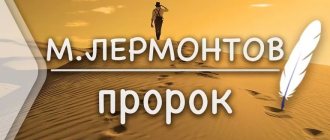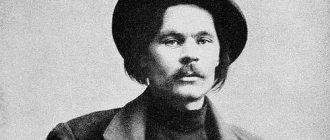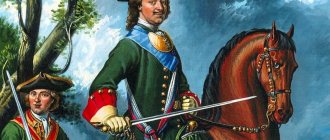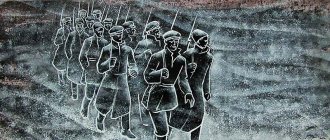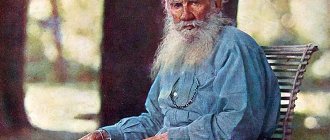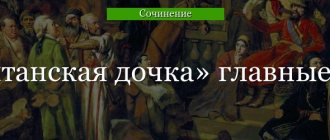The image of Peter I according to historical and literary sources: comparative analysis
This work is devoted to the study of the image of Peter I from historical and artistic sources. The work presents the views of famous historians and writers, their attitude towards this person, as well as similarities and differences in the historical and artistic image of Peter the Great.
Key words : Peter I, literary sources, historical sources.
In order to reliably study a particular era, famous person, or everyday situation, historians turn to related disciplines: archaeography, archeology, diplomacy.
Mostly, historians have studied ancient literary texts as a source. Fiction was considered very subjective; it often distorted the events of reality. The author of the work devotes a large role to his characters, endowing them with memorable features and empathy. Hence, fictional characters often interact with real ones, the course of events can move from one century to another, and the everyday situation is modernized by the author. All these criteria cause enormous difficulty in establishing the reliability of an event.
Authors of works of fiction often turn to historical events and personalities. For their future works, they turn to Russian folklore, study personal memoirs, documents, and surroundings. This way they can convey the spirit of the times and express their attitude. Such works are very interesting to analyze from a historical point of view.
One of the brightest historical figures who arouses the greatest interest among both historians and writers is Peter I. Attitudes towards the figure of Peter the Great himself and his reform activities are ambiguous. On the one hand, he was glorified as a great emperor who created a mighty power, and on the other hand, he was considered a cruel despot and Antichrist who destroyed Russian identity.
According to Vasily Osipovich Klyuchevsky, “Peter the Great, in his spiritual make-up, was one of those simple people whom you only need to look at to understand them” [2]. Unlike previous kings, Peter not only sent out decrees, but also actively participated in the life of the state. He was a hardworking man and, whenever possible, he was engaged in handicrafts, which helped to develop dexterity and resourcefulness. The Emperor always sought to comprehend a new matter before it was needed. Peter's love for manual labor caused him a certain fear and hatred of any ceremony. When he worked with his hands, he felt his power, independence from circumstances, but during audiences a feeling of helplessness arose. He tried to live simpler, like an ordinary person. Peter also showed his spiritual simplicity in his communication with others. When visiting, Peter did not look for a place of honor, but sat down at any free one; when he got hot, he could take off his caftan in front of everyone, and also, when eating food, he could do without a knife and fork. He could also play chess with people, smoke pipes and drink beer, not paying attention to others. He loved to have casual conversations with cheerful interlocutors. His habit of acting simply and directly in everything demanded the same dedication from other people.
The image of Peter described by Klyuchevsky is in many ways similar to the image described by Soloviev. In his public readings, he emphasizes that it was Peter’s curiosity and his love for manual labor that helped the Russian people get rid of their dependent position. The emperor, learning from the experience of foreigners, tried in every possible way to educate his people so that he would not have to invite foreigners and prevent them from doing what they wanted. Using the example of his attitude to war and diplomatic struggle, one can see that Peter was a patriot of his Motherland. Despite the temptations of foreigners that diplomacy and war should be best dealt with by trained foreigners rather than by Russians in training, Peter appointed Russians, believing that they needed to learn from their mistakes. Even in the administrative apparatus, a Russian person was put in first place, and a foreigner could take second place. Of course, foreigners were given certain benefits and were welcome, but he could not humiliate the Russian people and rule over them. Peter's patriotism connected him with the people. “Peter was himself a pure Russian man who maintained a strong connection with his people...” [3].
Karamzin develops a similar image of the ruler. In the book “Note on Ancient and New Russia,” the author emphasizes that Peter was very diligent and ready to achieve his goal no matter what. “He had generosity, insight, an unshakable will, activity, and rare tirelessness...” [1]. However, Karamzin highlights not only the positive features of the ruler and his activities, but also the negative ones. He takes as his basis the imposition of European customs on the Russian people. By introducing European manners, Russians humiliated themselves in their own country, becoming like foreigners. Karamzin believes that thanks to Peter, Russians became closer to the world, but ceased to be the Russian people. He believes that the reason for this is the instillation of everything foreign in Peter from childhood. The author also draws attention to Peter’s certain lust for power and extremes to achieve his goals. The imposition of European customs was carried out using harsh methods. All those who disagreed were punished or tortured. Suffice it to recall the decree of August 29, 1698 “On wearing German dress, on shaving beards and mustaches, on schismatics walking in the attire specified for them” or St. Petersburg - a new capital in the European style, built with hard work.
Fiction also repeatedly refers to the image of Peter the Great. This image was most vividly created in the works of A. S. Pushkin, A. N. Tolstoy and D. A. Granin.
The Peter the Great theme entered Pushkin’s work only from the end of 1826. It is most clearly represented in the works: “Stanzas”, “Arap of Peter the Great”, “Poltava” and “The Bronze Horseman”. In these works, the author reveals different features of Pyotr Alekseevich. On the one hand, he is a simple man, hardworking, fun-loving, comprehensively developed, concerned about the good of his country and people, but he also has another side. Peter is a despot, a tough autocrat who destroys everything old, everything popular, everything in which he sees an obstacle to his transformations. In his impatience, he did not take into account the serious consequences of certain reforms.
In the poem “The Bronze Horseman,” the poet does not set himself the task of painting the image of Peter: it is important for him to present the great king as the bearer of the idea of the power and prosperity of the state. The king himself remains in the distant past, but his power, will, and aspirations are personified in the monument by Falcone. It is interesting to note that neither the name Falcone nor the words “monument” or “monument” appear in the poem. Instead, periphrases are used: “an idol on a bronze horse,” “an idol with an outstretched hand,” “the lord of fate,” “the ruler of half the world,” “the formidable king,” the one “who stood motionless in the darkness with a copper head.” If in the introduction the living king is devoid of visible details, then in the second part of the poem the monument is endowed with signs of a living person. In the introduction, we recognize the “great thoughts” of the king, but do not see his face. In the main part, these thoughts are reflected “on the forehead” of the sculpture. Pushkin seems to assert that Peter continues to participate in the events of the present. His actions influence both his current life and even the future. The Bronze Horseman is Peter’s other “I,” as if responsible for everything that he accomplished and passed on to his descendants.
A. N. Tolstoy first turned to the image of Peter in the story “The Day of Peter” in 1918. In this story, Peter is an unkempt man, walking with a clubfoot and eating vodka and cucumber for breakfast, but at the same time powerful, intimidating and ready to do anything to achieve his goals. It is also interesting to look at Peter’s surroundings. From the description of his office it is clear that the Tsar is an active and versatile person. Through the people around him, Tolstoy ridicules European fashion, which was forcibly imposed on Russian society.
In achieving his goal, he did not think about the sacrifices that would need to be made, including human ones. This can be seen in the description of the construction of St. Petersburg. Construction was very difficult. Floods, fires, famine and plagues destroyed the people, who did not even understand the purpose of building a royal city in the swamps. All those who disagreed were taken to the Secret Chancellery or to the Preobrazhensky Prikaz, brutally tortured and could be killed.
Tolstoy revealed the image of Peter more widely in his novel Peter the Great. Here the author sought to show the need for the changes that the emperor would make. Peter is shown not as an idealized sovereign, but as an ordinary person with his positive and negative traits. When studying the image of Peter in the novel by Alexei Tolstoy, it is worth taking a closer look at his writing style. Here the author mixes historical facts with fictional characters, shifts the sequence of events, some historical figures say things that they did not actually say. The author tried to write a novel, and not a historically accurate treatise. Even if the author embellished them somewhere, he put realistic facts into the basis. His Peter I is both the people's king, and the beast of prey, and even the Antichrist.
In D. A. Granin’s book “Evenings with Peter the Great” you can see the author’s thoughts about this person and her significance in the history of Russia. Granin in this book relied on numerous historical facts and documents, which he himself studied. He interprets known facts in a new way, reveals new aspects of Peter’s life, and through his characters gives his assessment of his personality and actions. Many people put Peter as an example of the ideal image of a monarch. It was this ruler who accomplished a lot during his life and achieved his goals. He was a man of his time, able to understand what was needed. For example, the episode of the Streletsky revolt is often encountered. Unlike other authors, not only Peter’s psychological trauma is touched upon here, but also the formation of his strong and sometimes harsh character.
The author notes Peter's courage for violating the customs of the Russian court. It was Peter who traveled a lot abroad, studied new things and tried to teach this to Russia. Many blamed Peter for not implementing many of the projects that he himself conceived, but they forget how many years he spent on turmoil and war. And at the same time, many reforms have brought Russia to a new stage of development.
Each author, relying on generally accepted facts, interprets them in his own way. Some try to focus attention only on Peter’s positive traits, only briefly mentioning the negative ones, while others try to exaggerate the negative aspects. But there are those who view both sides of Peter equally. In many ways, the worldview of the authors plays a role here. You cannot blindly trust one or another source. Everything needs to be approached objectively, studying several sources. No one can reliably understand the necessity of certain actions of the sovereign. After all, it is very difficult to understand a person from a different historical era when your era, having a different worldview, leaves its mark.
Literature:
- Karamzin N. M. “Note on ancient and new Russia”, M.: “Nauka”, 1991. P. 31
- Klyuchevsky V. O. “Historical Portraits”, M.: “Eksmo”, 2008. P. 42
- Solovyov S. M. “Public readings about Peter the Great.” Reading fifth. [Electronic resource], - URL: https://az.lib.ru/s/solowxew_sergej_mihajlovich/text_0150.shtml#05
The image of Peter the Great in A. Tolstoy’s novel “Peter I”
Lesson on the topic: “The image of Peter in the novel by A.N. Tolstoy "Peter the Great"
Lesson objectives:
- give an idea of the changes in the author’s views on the role of Peter’s reforms;
- to identify the ideological and artistic task of A.N. Tolstoy - to show Peter the Great as a statesman brought to life by historical necessity;
- identify the role of artistic means in creating the image of Peter.
Org moment.
The importance of the topic for studying Tolstoy’s work. Setting lesson goals. The sound of the theme in the works of other writers. At this stage of the lesson, students turn to previously studied material, to lecture material from the previous lesson, and listen to the presentation of a specially prepared student.
- In previous lessons we talked about the work of A.N. Tolstoy, the features of his novel “Peter the First,” in the center of which is the image of Peter. It is to this image that we will devote our lesson.
- Write down the topic of the lesson in your notebook (/Presentation, slide No. 2/: The image of Peter in A.N. Tolstoy’s novel “Peter the First.”)
- What goals can we set for ourselves while working on this topic? (slide No. 3)
- characterize the image of Peter in the novel;
- identify the artistic means used by the author to create the image of Peter.
| Story “The Day of Peter” | Novel “Peter the Great” |
| ...the damp wind drove a strong fog from the sea...it blew away rotten straw from huts and cages... Bloated the river flowed into the log embankments... The royal city was built on the edge of the earth, in the swamps, right next to the wilderness. Who needed him? , for what kind of | ...The open sea was just a stone's throw away from here. The wind covered him cheerful swell. …Desired, beloved there was a place here. |
We present to your attention episodes that describe the construction of St. Petersburg. On the left are excerpts from the story, and on the right are from the novel. We invite you to compare them. What makes these two descriptions different from each other?
So, Tolstoy’s view of the role of Peter the Great’s reforms underwent changes. After returning to his homeland in 1922, Tolstoy came to the conclusion that reforms were necessary.
3. Portrayal of Peter in the novel. The formation of Peter's personality. The need for transformation. Artistic means of depicting Peter.
Doing homework, working with text.
Now we turn to the image of Peter in the novel.
When we talked about the composition of the novel, we noted that it was dictated by the goal of showing the formation of Peter’s personality. How does Tolstoy’s portrayal of Peter differ from Pushkin’s? (Pushkin has Peter as an established personality)
- Tell us how Tolstoy depicts the development of Peter’s personality? (Presentation, slide No. 5)
Student answers.
- Prove with examples from the text that Russia needed transformation. Did Tolstoy reflect the contradictory nature of Peter's transformations? (Presentation, slide No. 9)
Student answers. (It is possible to use slides No. 6-8 (Presentation, slides 6-8), illustrating the need for transformations).
- Why was it Peter, and not Golitsyn, who was able to become the transformer of Russia? (Presentation, slide No. 10)
Student answers.
- Speaking about Peter, one cannot help but pay attention to the artistic means used by the author. Which tools do you think play the most important role? (Presentation, slide No. 11)
(reception of contrast, speech characteristics).
- Give examples of using contrast in the text.
- What are the features of Peter's speech?
(laconism, emotionality, imagery, closeness to folk). (Presentation, slide No. 12)
- Pay attention to a small excerpt from the text (Presentation, slide No. 13): “Peter pulled the door open... On two moved benches, with his head covered, Streshnev was sleeping. Peter tore off the blanket. He grabbed the frightened boyar by the thin hair... spat in his face, dragged him to the dirt floor, and beat him with his jackboot...”
What helps the author convey Peter’s ardor and temper? (abundance of verbs). (Presentation, slide No. 14)
- Tolstoy admitted: (Presentation, slide No. 15): “In a person, I try to see a gesture that characterizes his state of mind, and this gesture is shown to me by a verb in order to give a movement that reveals psychology.”
So, an important means of revealing the image of Peter is the “internal gesture,” a technique consisting in the use of verbs to convey the psychological state of the hero.
- Write down in your notebook the main artistic means used by the author to create the image of Peter (Presentation, slide No. 16)
4.
Generalization of the material.
Summarizing. Homework. It's time to sum up our lesson. Tell us briefly about the results of our work (Presentation, slide No. 17).
- Tolstoy carried his interest in the image of Peter throughout his entire work;
- the author's views on the role of Peter's reforms underwent changes;
- in the novel “Peter the Great” Tolstoy showed the formation of Peter’s personality and the need for transformation;
- the novel reflects the contradictory nature of Peter's activities;
- The following artistic means became the most significant in creating the image of Peter: “internal gesture”, the technique of contrast, speech characteristics. (Students write in their notebooks)
Homework
for a lesson on the topic “The Image of Peter in A.N. Tolstoy’s novel “Peter the Great”.
Book 1, chapter 7, 4.
| What role does the description of the landscape play in this episode? List the artistic means by which the creation of such a background is achieved. |
| How does Peter appear in this scene? |
| What role does this episode play in the text? |
| Describe Peter's speech. |
Image of Peter the Great
A. N. Tolstoy approached the novel “Peter the Great” gradually and from afar. First, back in the 20s, he wrote the stories “The First Terrorists”, “Obsession”, “The Day of Peter”, and then “The Tale of Troubled Times” and the play “On the Rack”. And only at the end of all this does he begin to work on the novel “Peter the Great”. The writer himself noted: “Working on “Peter” for me, first of all, is an entry into history through modernity... The result is that history began to reveal untouched riches to me.”
In his novel, A. Tolstoy created a complete picture of Russia - from the imperial palace to the wretched peasant hut; painted the life of the country against a broad European background. But history does not act as a background for the writer. The authentic events of Russian history in its movement and struggle form the basis of the plot in the novel. And this is one of the author’s great achievements.
The central person to whom the threads of the historical movement of the era converge in the novel, the plot center of the entire narrative in A. Tolstoy is Peter I. The writer sees the strength of Peter, his merit and significance in the fact that he understood the objective laws and requirements of his era, subordinated his activity. The transformation of Russia, the implementation of broad political plans - the work of Peter's whole life. In A. Tolstoy’s portrayal, Peter is, first of all, a major statesman and national figure. He is the son of his century, an ardent patriot of Russia and at the same time a multifaceted personality, endowed with all the main features of the transitional era.
The composition of the work, along with the movement of “big history,” is based on the development of Peter’s character, his maturation. The writer shows the gradual transformation of a naughty, persistent, hot-tempered, restive boy, a “wolf cub”, in the words of Princess Sophia, an angular teenager, a long, restless “young man” into an unyielding ruler, a brilliant reformer, a formidable military leader, a wise diplomat, a great statesman and political figure.
A. Tolstoy endowed his hero with human feelings and passions, created a living image of Peter with his insatiable love of life, stormy temperament, indomitable daring will, “wild, greedy, alarmed mind,” acute curiosity, tough, tough disposition.
Peter's youth and youth were full of sharp, dramatic clashes and intense struggles for power. Early on, from childhood, an irreconcilable hatred began to speak in him for the conservative, stuffy antiquity, for the immobile way of old Moscow, for the slow and tedious boredom of magnificent palace ceremonies, for the arrogant and arrogant boyars, who could only doze lazily on their benches. From the personal feeling of this hatred, his principles grew over time, giving impetus to his passionate activity, turning into an inexhaustible source of energy, encouraging him to destroy the old, objectionable, to search for and coolly implement the new.
Peter's greedy and inquisitive mind, his characteristic practical acumen, and foresight give him the opportunity to grasp and feel the tasks facing the Russian state before many others. With all the strength of his character and temperament, Peter sets out to break and eradicate backward orders, to create an army and navy. He shaves the boyars’ beards, dresses the boyars’ daughters in dresses “with slaps” and teaches them “polites,” and sends their sons abroad to study various sciences and at the same time wages a persistent struggle for Russia’s access to the seas, promotes the development of Russian trade with the West, builds factories, founds the new city of St. Petersburg. Peter's thoughts are constantly turned to his homeland, to his country. Peter experiences acute resentment and pain for the poverty and scarcity that he sees in his Rus': “What kind of Russia is this, a cursed country, when will you move?”
He throws angry words at the boyars: “In all Christian countries - and there are some that are not even worth our district - trade is growing fat, people are getting richer, everyone is looking for their own profit... Only we alone are sleeping soundly. Soon the Russian land will be called a desert.” With bitterness he exclaims: “The devil brought me to be born a king in such a country!” How modern all these words sound today!
Peter becomes an autocratic ruler and, overcoming the resistance of the boyars, decisively enters into the struggle with Old Russia for New Rus'. The first book of the novel ends with meaningful words: “The old is hidden in dark corners. Byzantine Rus' was ending. In the March wind, the ghosts of merchant ships could be seen beyond the Baltic coasts.”
A. Tolstoy’s Peter is a very down-to-earth man, a son of his era. Tolstoy often depicts his Peter with a wheelbarrow at a construction site, with an ax at a shipyard or with a sledgehammer in a forge. He is simple, hardworking, active, and does not shy away from people of “vile rank.” Most often, Peter is shown not in royal clothes, but either in a military caftan, or in a “stained canvas shirt with sleeves rolled up to the elbows,” or in a sailor jacket. Tolstoy emphasizes both Peter’s “peasant” manners and his passion for strong words. While visiting the German Electors, ladies who were both well-mannered and educated, he “wipe his hands on the tablecloth, slurped loudly, used sailor words, winked with his round eye and, for emphasis, tried more than once to nudge Sophia-Charlotte with his elbow.”
Peter's characteristic mockery and sly humor also manifests itself. The author depicts his hero-king sometimes in far from heroic moments: in a state of panic fear and confusion or uncontrollable anger, in moments of his inner confusion, depression and grief, in funny family quarrels with his wife, in love scenes with Anna Mons. But all this, however, does not obscure the main and most important thing in Peter - his state activity. The writer strives to show Peter in the context of his affairs, decisions made, in the thick of events.
In the third volume of the novel, we see Peter already fully formed: both as a person who has become restrained and reasonable, and as a statesman who is deeply aware of the enormous responsibility for the fate of Russia. And it is no coincidence that the author now calls him not just Peter, but Peter Alekseevich.
However, A. Tolstoy nowhere strives to present Peter as an ideal figure, to make him more humane and humane than he actually was. While creating the image of Peter, the writer at the same time did not forget that he was an autocrat, a serf owner. Peter's reforms often had the character of a sharp, decisive and brutal break. In the novel, Peter asks himself an impatient question: “With what forces to push people aside, to open their eyes?.. Give some kind of terrible decree? Rehang? Should I flog you?” He forcibly cuts off the beards of the boyars, participates in the cruel torture of his enemies, uses a “club” to drive noblemen into science, and arranges the desecration of princely and old boyar families at Christmastide. It is under him, the serf-owner Tsar, that the people's, peasant Rus' is groaning from unbearable exactions and quitrents. It is under him that the poor are flogged to death with batogs, serfs are driven into shipyards, soldiers are taught with sticks, free people are deceived into entering cloth, linen, silk factories and paper mills erected by order of the tsar.
“Peter the Great” is a work about a great era with its statesmen and masses, with its contradictions and conflicts, with difficulties and victories. The heroes of the novel are put forward by history, but at the same time they themselves are its participants and creators. The main idea of A. Tolstoy’s novel is the idea of the power of the great Russian people. This makes the book a noticeable phenomenon of national consciousness.
In the 1920s-1930s. XX century Soviet literature clearly showed an increased interest in historical topics, in the past of our homeland. This became a determining factor in the successful development and spread of the historical genre in our literature of this period. The main theme of all these novels was the growth of popular protest and the strengthening of the liberation struggle of the masses. No less important was the topic of the formation of Russian statehood. The novel “Peter the Great” was called by A. M. Gorky “the first real historical novel in our literature.” A. Tolstoy himself admitted that the personality of Peter the Great attracted his attention throughout his life. He was interested not only in Peter the Great as a politician, but also as a person, an ordinary person.
Throughout his life, the author turned to this image. Peter the Great appeared either in the story “The Day of Peter” or in the play “On the Rack”. Over time, the image of the king changed. In earlier works, Peter the Great is the antichrist king, arousing the hatred of the people. In “Peter the Great” there is no unambiguous negative assessment of Peter’s activities.
On the one hand, Peter the Great in the novel is a major national figure. He is a gifted man, a patriot, he contains the best features of the Russian national character - perseverance, perseverance, determination. But at the same time, in the novel the author does not absolutize the greatness of Peter. The work also shows the shadow sides of his activities. The novel shows Peter's struggle with barbarism and shows how unbearable the costs of reforms fell on the shoulders of the common people. Many pages are devoted to a vivid depiction of the plight of the peasantry, exploited, crushed by extortions, and tortured by conscription. Peter is presented as a king who uses harsh serfdom methods of exploitation of oppression. “The treasury is strict, there is no money - take off your fur coat.” The peculiarity of the image of Peter is that he appears in the novel as a ready-made, already established personality. Tolstoy shows the entire process of formation of the king's personality. From chapter to chapter, his image is replenished with new features. Before our eyes, Peter transforms from a young and angular youth into a mature statesman. This is how we see Peter at the beginning of the book: “Peter was very good at playing - he could play for a day without sleep, without food, at anything, it would be noisy, fun, amusing.” But after some time, Peter is a significantly changed, serious, purposeful person, ready to devote himself entirely to the cause. “Peter was now constantly seen driving around the camps on a shaggy horse. Grass whipped across his thin legs.”
How does the author create the image of Peter and other characters? Many methods are known in literary criticism - self-disclosure of the hero in the plot, portrait characterization, internal monologue, detailed author's characterization. From all this diversity, A. Tolstoy chose only a few, but brought them to perfection. First of all, the hero is revealed in the plot; instead of the author's characterization, the perception of one character by different characters is used; Instead of a detailed description of the external appearance, individual repeating details of the appearance are scattered throughout the text of the narrative, from which a dynamic, psychologically reliable portrait of the hero is formed. In the novel, Peter is characterized as “like a pole,” clumsy, as if dressed “not for his height,” “with crane legs,” “thin and thin, with clubbed feet”; but with an “arrogant, proud, furious” look.
For the first time we meet a frightened child in a monomachian hat that has slipped to one side, when, at the request of the rebellious archers, the Tsarina and Matveev show him from the porch to the people. The author describes Peter's youth, his youth full of dramatic clashes and intense struggle for power. Peter gradually gains strength, accumulates experience, goes through the inevitable stage of first failures and defeats, and outlines ways to implement the transformations he has planned.
In the third book, when A. Tolstoy depicts his arrival in the newly rebuilt St. Petersburg or when Peter is shown stopping the victorious assault on Narva, in the scene of the official surrender of the Swedes, he seems to grow on his head, his majestic posture, imperious calm, and confidence are emphasized. within himself the ruler of one of the strongest European states.
The artistic persuasiveness of the image of Peter stems from the fact that he is shown not only in his state activities, but also in a simple, human aspect, and the inner spiritual world of the hero is revealed with great insight. Peter is no stranger to many human weaknesses. Sometimes the author depicts him in far from heroic moments. For example, near Lake Pereyaslavl we see him half-dressed, snoring peacefully in a boat, with bare dirty feet, which he moves in his sleep, fighting off flies. Tolstoy also shows Peter at the moment of his inner turmoil, grief, when he is deeply shocked by the death of his mother or the death of his favorite Lefort.
Drawing Peter, many other heroes, their destinies, events, the author emphasizes the active, dynamic, active principle characteristic of the turbulent era of Peter the Great. This dynamic also affects the fate of Russia. Representatives of some layers rise quickly, while others find themselves thrown back sharply. The fate of a country is the sum of the destinies of its people.
Throughout the novel there are pictures of poverty, overcrowding, popular oppression and lack of rights. The difficult situation of the lower social classes in Russia at the end of the 17th and beginning of the 18th centuries. is depicted by A. Tolstoy in all its ugliness. We see peasants, courtyard slaves, soldiers, bankrupt townspeople, runaway people who “drag between the yards”, suffering from extortions, taxes, countless mobilizations, oppression from the authorities and the powerful.
Russia was in a period of breaking down old state foundations and forming new ones.
At this time, the memory of the recent Razin uprising did not die among the masses. The author shows this silent protest seething among the people, growing and intensifying. Thus, he prepares readers for the episodes of open speech of the masses, which he wanted to give when depicting the Bulavin movement.
So, Russia in the era of Peter the Great, on the one hand, was a new, young, reborn country, striving for the better, but, on the other hand, a country in which life for the people was unattractive and painful. The people as depicted by A. Tolstoy are an inexhaustible source of energy, intelligence, and talent. It is the people who are the essence of Russia. It was through the efforts of the people, their daily labor, that the greatness and power of the Russian state was created.
This whole process is depicted in detail and emotionally in the novel “Peter the Great”.
Section materials
September 29, 14:12
The last echelons to the west. Why did the USSR supply Germany?
September 29, 10:03
They planned to make soap from the bodies of the dead. Nazi massacres at Babi Yar
September 23, 14:36
The best in skeet. How the Leningrad riflemen won
September 23, 10:23
Life cable. How the energy blockade of Leningrad was broken
September 21, 12:02
